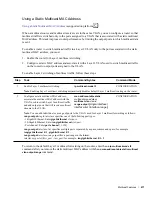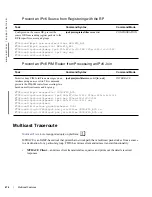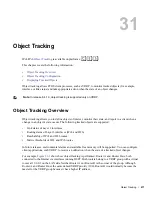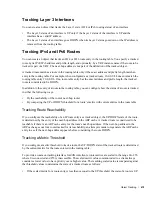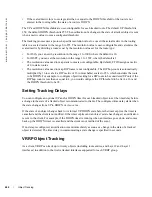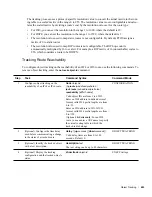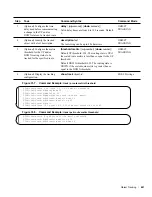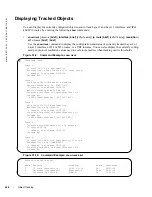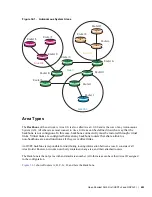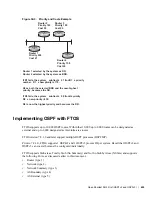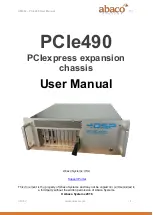
684
|
Object Tracking
www.dell.com | support.dell.com
Figure 31-4. Command Example:
track interface ipv6 routing
Tracking an IPv4/IPv6 Route
You can create an object that tracks the reachability or metric of an IPv4 or IPv6 route. You specify the
route to be tracked by its address and prefix-length values. Optionally, for an IPv4 route you can enter a
VRF instance name if the route is part of a VPN routing and forwarding (VRF) table. The next-hop address
is not part of the definition of a tracked IPv4/IPv6 route.
In order for an route’s reachability or metric to be tracked, the route must appear as an entry in the routing
table. A tracked route is considered to match an entry in the routing table only if the exact IPv4 or IPv6
address and prefix length match an entry in the table. For example, when configured as a tracked route,
10.0.0.0/24 does not match the routing table entry 10.0.0.0/8. Similarly, for an IPv6 address,
3333:100:200:300:400::/80 does not match routing table entry 3333:100:200:300::/64. If no route-table
entry has the exact IPv4/IPv6 address and prefix length, the tracked route is considered to be DOWN.
In addition to the entry of a route in the routing table, you can configure the UP/DOWN state of a tracked
route to be determined in the following ways:
•
By the reachability of the route's next-hop router
The UP/DOWN state of the route is determined by the entry of the next-hop address in the ARP cache.
A tracked route is considered to be reachable if there is an ARP cache entry for the route's next-hop
address. If the next-hop address in the ARP cache ages out for a route tracked for its reachability, an
attempt is made to regenerate the ARP cache entry to see if the next-hop address appears before con-
sidering the route DOWN.
•
By comparing the threshold for a route’s metric with current entries in the route table
The UP/DOWN state of the tracked route is determined by the threshold for the current value of the
route metric in the routing table.
To provide a common tracking interface for different clients, route metrics are scaled in the range 0 to
255, where 0 is connected and 255 is inaccessible. The scaled metric value communicated to a client
always considers a lower value to have priority over a higher value. The resulting scaled value is com-
pared against the configured threshold values to determine the state of a tracked route as follows:
•
If the scaled metric for a route entry is less than or equal to the UP threshold, the state of a route is
UP.
•
If the scaled metric for a route is greater than or equal to the DOWN threshold or the route is not
entered in the routing table, the state of a route is DOWN.
The UP and DOWN thresholds are user-configurable for each tracked route. The default UP threshold
is 254; the default DOWN threshold is 255. The notification of a change in the state of a tracked object
is sent when a metric value crosses a configured threshold.
FTOS(conf)#track 103 interface gigabitethernet 7/11 ipv6 routing
FTOS(conf-track-103)#description Austin access point
FTOS(conf-track-103)#end
FTOS#show track 103
Track 103
Interface GigabitEthernet 7/11 ipv6 routing
Description: Austin access point
IPv6 routing is Down (shutdown)
2 changes, last change 00:03:25
Tracked by:
Summary of Contents for Force10 E300
Page 1: ...FTOS Configuration Guide FTOS 8 4 2 7 E Series TeraScale C Series S Series S50 S25 ...
Page 32: ...32 w w w d e l l c o m s u p p o r t d e l l c o m ...
Page 132: ...132 802 1X w w w d e l l c o m s u p p o r t d e l l c o m ...
Page 310: ...310 Configuration Replace and Rollback w w w d e l l c o m s u p p o r t d e l l c o m ...
Page 330: ...330 Dynamic Host Configuration Protocol w w w d e l l c o m s u p p o r t d e l l c o m ...
Page 402: ...402 High Availability w w w d e l l c o m s u p p o r t d e l l c o m ...
Page 462: ...462 Interfaces w w w d e l l c o m s u p p o r t d e l l c o m ...
Page 482: ...482 IPv4 Addressing w w w d e l l c o m s u p p o r t d e l l c o m ...
Page 506: ...506 IPv6 Addressing w w w d e l l c o m s u p p o r t d e l l c o m ...
Page 582: ...582 Layer 2 w w w d e l l c o m s u p p o r t d e l l c o m ...
Page 642: ...642 Multicast Source Discovery Protocol w w w d e l l c o m s u p p o r t d e l l c o m ...
Page 662: ...662 Multiple Spanning Tree Protocol w w w d e l l c o m s u p p o r t d e l l c o m ...
Page 690: ...690 Object Tracking w w w d e l l c o m s u p p o r t d e l l c o m ...
Page 754: ...754 PIM Dense Mode w w w d e l l c o m s u p p o r t d e l l c o m ...
Page 784: ...784 PIM Source Specific Mode w w w d e l l c o m s u p p o r t d e l l c o m ...
Page 800: ...800 Power over Ethernet w w w d e l l c o m s u p p o r t d e l l c o m ...
Page 876: ...876 Quality of Service w w w d e l l c o m s u p p o r t d e l l c o m ...
Page 892: ...892 Routing Information Protocol w w w d e l l c o m s u p p o r t d e l l c o m ...
Page 1006: ...1006 Simple Network Management Protocol w w w d e l l c o m s u p p o r t d e l l c o m ...
Page 1018: ...1018 SONET SDH w w w d e l l c o m s u p p o r t d e l l c o m ...
Page 1048: ...1048 Broadcast Storm Control w w w d e l l c o m s u p p o r t d e l l c o m ...
Page 1096: ...1096 Uplink Failure Detection UFD w w w d e l l c o m s u p p o r t d e l l c o m ...
Page 1098: ...1098 Upgrade Procedures w w w d e l l c o m s u p p o r t d e l l c o m ...
Page 1196: ...1196 C Series Debugging and Diagnostics w w w d e l l c o m s u p p o r t d e l l c o m ...
Page 1252: ...1252 Standards Compliance w w w d e l l c o m s u p p o r t d e l l c o m ...
Page 1262: ...1262 Index w w w d e l l c o m s u p p o r t d e l l c o m ...


